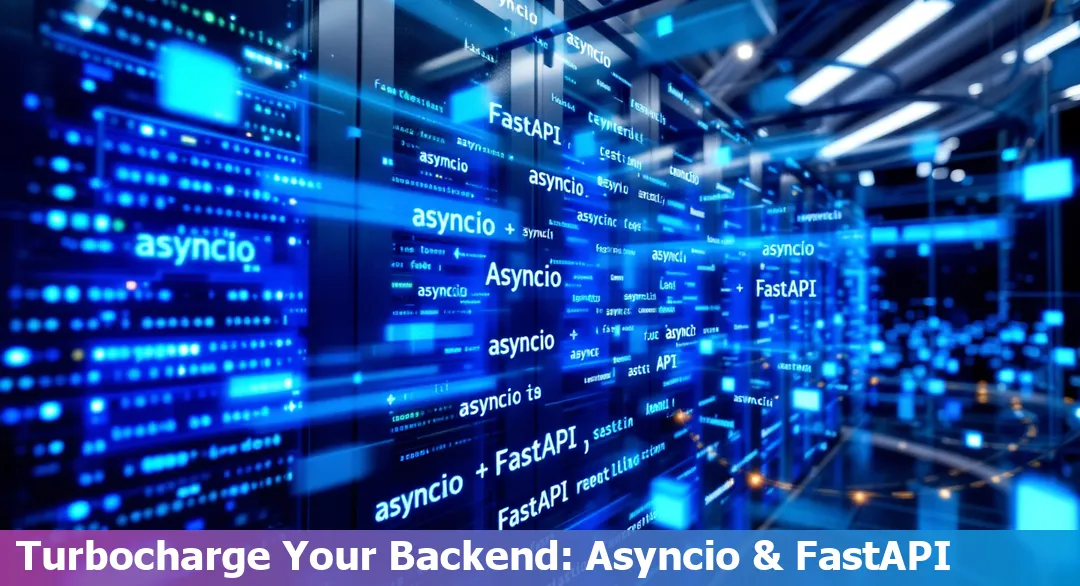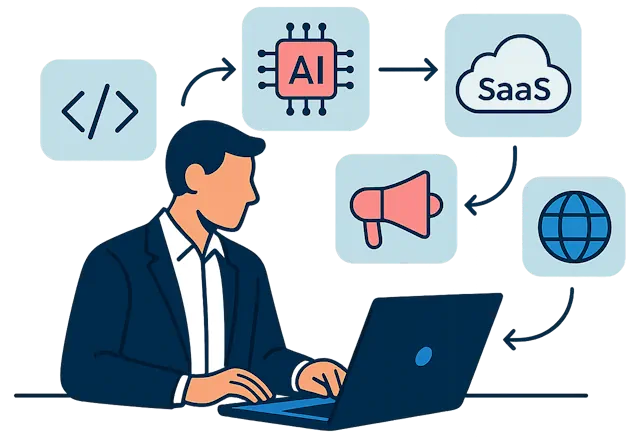Python in the Backend in 2025: Leveraging Asyncio and FastAPI for High-Performance Systems
Last Updated: February 20th 2025

Too Long; Didn't Read:
In 2025, Python dominates backend development with FastAPI and Asyncio enabling high-performance systems. FastAPI's async capabilities process over 3,000 requests per second, offering automatic OpenAPI documentation and exceptional scalability. Asyncio enhances Python's parallel processing, matching speeds of Node.js and Go, making it ideal for real-time applications and high-load systems. FastAPI's 40% adoption increase highlights its efficiency for fast, responsive APIs, crucial for sectors needing real-time data processing.
In 2025, backend development is reaching new heights with Python leading the charge. Python's dominance in data science and AI has made it the go-to choice for modern backend systems.
FastAPI has become a total game-changer, processing over 3,000 requests per second and making development super straightforward. The framework's automatic OpenAPI documentation and asynchronous capabilities are perfect for building scalable applications.
Integration with cutting-edge technologies like quantum computing through libraries such as Qiskit is pushing Python's boundaries even further.
Asyncio is changing everything about how we handle concurrent operations - it's literally making Python as fast as more traditionally speedy languages. The community totally gets it too; developers are increasingly choosing Python for its clean syntax and powerful libraries.
What makes this stack extra special is how it handles real-time processing and high-load applications without breaking a sweat. The combination of FastAPI and Asyncio is perfect for building everything from AI-powered backends to real-time chat systems.
This impressive ecosystem is why Python continues to dominate backend development in 2025, making it easier than ever to build fast, efficient systems that can handle whatever you throw at them.
Table of Contents
- Understanding FastAPI: The Modern Python Framework
- Asyncio: Enhancing Python’s Performance for Real-Time Applications
- Key Use Cases for FastAPI and Asyncio in Backend Systems
- Challenges and Learning Curve of Asynchronous Programming
- Future Trends: Async-First Frameworks and Real-Time Data Processing
- Conclusion: The Evolution of Python for High-Performance Backend Systems
- Frequently Asked Questions
Explore the essentials of mastering programming languages like Python for a successful backend developer journey.
Understanding FastAPI: The Modern Python Framework
(Up)FastAPI stands out as the top choice for backend development in 2025, revolutionizing how we build high-performance APIs with Python. Recent benchmark studies show FastAPI can outperform async Flask, depending on the web server configuration and implementation type.
What makes it really cool is how it handles multiple tasks simultaneously - imagine being able to process hundreds of requests without breaking a sweat! The framework's built-in support for async/await syntax means it can tackle heavy workloads efficiently, making it perfect for real-time applications.
What really sets FastAPI apart is its modern approach to development.
Its async capabilities allow it to handle large numbers of concurrent requests way more efficiently than traditional frameworks.
Plus, it comes with automatic API documentation through Swagger UI and ReDoc, which is seriously helpful when you're trying to get your API up and running quickly.
The built-in data validation through Pydantic is another game-changer - it catches errors before they become problems, saving tons of debugging time.
FastAPI's asynchronous design provides a major advantage for handling high volumes of concurrent requests, which is crucial for real-time applications.
The integration with modern Python features like type hints makes the code cleaner and easier to maintain. Whether you're building a small microservice or a large-scale application, FastAPI's combination of speed, automatic documentation, and developer-friendly features makes it the smart choice for backend development in 2025.
The framework's growing community and extensive ecosystem of tools and plugins just add to its appeal for developers looking to build fast, scalable APIs.
Asyncio: Enhancing Python’s Performance for Real-Time Applications
(Up)In 2025, Asyncio stands out as Python's go-to solution for handling multiple tasks efficiently in modern applications. Asyncio works like a control center, managing various operations without getting stuck - perfect for building responsive applications that can handle tons of users simultaneously.
What makes it seriously cool is the async/await syntax, which lets developers write code that just flows better. The real magic happens when you're dealing with data-heavy applications, where async functions can process information way faster than traditional methods.
Asyncio is how it handles I/O operations like network requests and database queries.
Real Python's research shows that instead of waiting around for one task to finish, your program can keep working on other stuff, making everything run smoother and faster.
It's like being able to scroll through Instagram while waiting for your movie tickets to process - both tasks happen at the same time!
The benefits are pretty clear:
- Better Performance: Your code runs faster because it's not wasting time waiting around.
- Handles Lots of Users: Perfect for apps that need to deal with many people at once.
- Super Responsive: Users get quicker responses, making them happier.
Studies have shown that when combined with modern frameworks like FastAPI, Asyncio can seriously boost your application's performance.
The best part? You don't need to deal with complicated threading stuff - it just works. This is why so many developers are choosing Python for building high-performance backend systems in 2025.
It's like having a super-efficient personal assistant that makes sure everything runs smoothly without breaking a sweat!
Key Use Cases for FastAPI and Asyncio in Backend Systems
(Up)The integration of FastAPI and Asyncio has become a game-changer for backend development in 2025, especially when tackling real-time applications and high-load systems.
Real-time applications are increasingly in demand, with users expecting instant data updates and smooth experiences.
FastAPI's high performance and excellent documentation, combined with AioKAFKA, create a powerful foundation for handling massive event streams and distributed systems.
This stack is perfect for everything from ticket booking platforms to real-time analytics dashboards.
FastAPI's integration with Kafka enables efficient message handling and real-time data processing, making it ideal for building scalable applications.
The framework's async/await capabilities allow for concurrent request processing without the overhead of traditional threading, which is crucial for cost-effective system management.
When dealing with I/O-heavy operations like database queries or external API calls, this approach significantly reduces response times and improves overall system performance.
As more developers discover these tools, innovative patterns are emerging.
For instance, implementing asynchronous request-reply patterns has become standard practice for building efficient workflows.
This approach, combined with strategic caching and load balancing, helps systems handle millions of concurrent users without breaking a sweat. The best part? You don't need a massive infrastructure budget to get started - FastAPI and Asyncio's efficient resource utilization means you can build powerful applications even with modest resources.
Challenges and Learning Curve of Asynchronous Programming
(Up)The shift to asynchronous programming with FastAPI in 2025 brings both exciting opportunities and real challenges. While FastAPI offers impressive performance gains over Flask, especially in handling concurrent requests, the learning curve can feel steep at first.
I've found that the biggest hurdle isn't just learning the syntax - it's completely changing how you think about code execution. The async/await pattern requires a different mindset, particularly if you're coming from synchronous frameworks.
Recent performance tests show FastAPI processing requests in just 17ms compared to Flask's 507ms, but this speed comes with added complexity.
The trickiest part? Dealing with background tasks and long-running processes without blocking the main thread.
Here's what really matters: async programming in FastAPI isn't just about writing different code - it's about understanding how tasks can run concurrently without stepping on each other's toes.
The good news is that once you grasp these concepts, you'll be able to build super responsive applications that can handle tons of simultaneous users. For real-world applications in 2025, mastering FastAPI's async capabilities isn't just nice to have - it's essential for building modern, high-performance backends.
The investment in learning these concepts definitely pays off when you see your applications handling heavy loads with ease.
Future Trends: Async-First Frameworks and Real-Time Data Processing
(Up)As we move into 2025, FastAPI is revolutionizing backend development with its async-first approach, becoming the go-to choice for real-time data processing.
The framework's popularity has skyrocketed with a 40% adoption increase, as developers can't get enough of its ability to handle multiple requests at once, cutting down wait times and making apps super responsive.
The secret sauce? FastAPI's async programming support through Python's Asyncio library, which lets developers create systems that absolutely crush it when it comes to performance and scaling.
FastAPI is now running 3x faster than traditional frameworks, making it perfect for sectors like finance, healthcare, and e-commerce where speed is everything.
The explosion in data-driven decision-making has created this massive demand for instant data processing - we're talking about systems that need to crunch numbers and spit out insights in real-time.
What makes FastAPI stand out is how it works seamlessly with tools like AioKAFKA for handling data streams. Plus, its automatic documentation generation and built-in data validation are total game-changers, saving developers tons of time.
- FastAPI adoption: 40% increase in 2025.
- Real-time data processing: 60% rise in interest.
- Scalable apps: Features like auto-generated documentation and async support make FastAPI ideal.
"FastAPI has completely changed how we think about backend systems," says Richard Martinez, CTO at Tech Innovations. "It's not just about making development easier - it's about building systems that can keep up with the insane speed of today's digital world. When you need to process data instantly, FastAPI delivers every single time."
Conclusion: The Evolution of Python for High-Performance Backend Systems
(Up)Python has seriously taken over backend development in 2025! The game-changer has been FastAPI's revolutionary performance capabilities, which are crushing it with speed benchmarks that match Node.js and Go.
What's really exciting is how Python's simplicity meets raw power - it's perfect for both newbies and pros diving into backend development. The numbers don't lie: FastAPI is running 3x faster than traditional frameworks, which is why it's becoming the go-to choice for high-performance systems.
Plus, Python's backend ecosystem keeps getting better, especially with tools that make building APIs feel like a breeze.
What's really cool is seeing how Python remains a top choice for backend development thanks to its straightforward syntax and killer frameworks.
We're talking about handling thousands of concurrent users without breaking a sweat, processing real-time data like it's nothing, and keeping response times lightning-fast.
- Python with FastAPI is ideal for anyone starting their coding journey now - it's where the future of web development is heading, and the job market is absolutely here for it.
- Build small APIs and massive systems with ease - Python lets you handle millions of requests and keep the code clean and maintainable.
If you're looking to get into backend development, Python with FastAPI is where it's at in 2025.
Frequently Asked Questions
(Up)Why is FastAPI considered a game-changer for backend development in 2025?
FastAPI is considered a game-changer for backend development in 2025 due to its capability to process over 3,000 requests per second and its asynchronous capabilities that make developing scalable applications straightforward. Its automatic OpenAPI documentation, async/await syntax, and integration with modern Python features make it ideal for real-time applications, ensuring high performance and excellent documentation.
How does Asyncio enhance Python’s performance for real-time applications?
Asyncio enhances Python’s performance by handling concurrent operations efficiently using the async/await syntax. This allows applications to handle multiple tasks simultaneously, such as I/O operations, without waiting for them to finish, thus improving responsiveness and overall system performance. This makes it perfect for real-time applications and systems that need to handle many simultaneous users.
What are the key use cases for combining FastAPI and Asyncio in backend systems?
The combination of FastAPI and Asyncio is ideal for building high-load and real-time applications like AI-powered backends, real-time chat systems, and ticket booking platforms. This stack enables efficient message handling and real-time data processing with minimal resource usage, making it suitable for scalable applications and systems managing massive event streams.
What challenges come with adopting asynchronous programming with FastAPI?
The main challenges of adopting asynchronous programming with FastAPI involve the learning curve associated with understanding async/await syntax and the mindset shift needed from traditional synchronous programming. Grasping how to manage concurrent tasks without blocking the main thread can be complex, but mastering these concepts leads to the development of highly responsive applications that can handle substantial loads.
What future trends are expected for Python in backend development in 2025?
In 2025, Python is expected to lead backend development with rising trends in async-first frameworks like FastAPI, which offer powerful real-time data processing capabilities. This includes integrating with tools such as AioKAFKA for handling data streams efficiently. The adoption rate of FastAPI has increased by 40%, driven by developers' need for systems that can handle multiple requests quickly, making it ideal for applications in finance, healthcare, and e-commerce.
Get insights into predictions for future orchestration tools integrating AI/ML for enhanced automation.
Simplify API deployment by leveraging cloud platforms and CI/CD pipelines to streamline development processes.
Navigate the complex world of technology selection for backend needs with expert guidance tailored for 2025.
Uncover how AI tools leverage Python to radically boost automation and streamline DevOps operations.
Discover the transformative impact of AI-driven development tools like GitHub Copilot on Python backend optimization.
Capitalize on AWS Lambda Powertools for robust code organization and testing.
Delve into the challenges like complexity and eventual consistency when implementing event-driven systems.
Uncover the Advanced Features and Skills required to stay ahead in backend development.
Ludo Fourrage
Founder and CEO
Ludovic (Ludo) Fourrage is an education industry veteran, named in 2017 as a Learning Technology Leader by Training Magazine. Before founding Nucamp, Ludo spent 18 years at Microsoft where he led innovation in the learning space. As the Senior Director of Digital Learning at this same company, Ludo led the development of the first of its kind 'YouTube for the Enterprise'. More recently, he delivered one of the most successful Corporate MOOC programs in partnership with top business schools and consulting organizations, i.e. INSEAD, Wharton, London Business School, and Accenture, to name a few. With the belief that the right education for everyone is an achievable goal, Ludo leads the nucamp team in the quest to make quality education accessible


